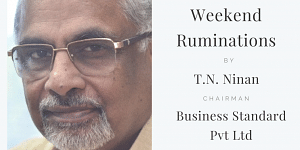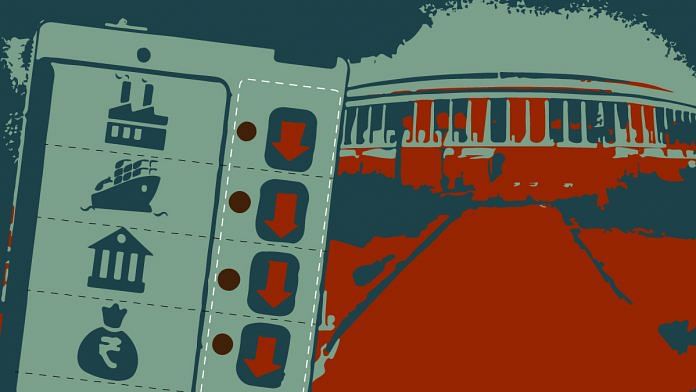Once the dust raised by the elections has settled, a new government will have to deal with the economic slowdown. The issue to focus on is not the usual one of how long growth will stay in the 6.5 per cent region before moving back up to 7 per cent and beyond. First, because we should not assume automatic reversion to what existed before, and second because the credibility of the GDP (gross domestic product) numbers has been shredded. Instead, the focus has to be on real numbers that can’t be fudged, and these tell a troubling story.
Merchandise exports have been flat for most of the last five years. This reflects the failure of domestic manufacturing, and has made the economy more inward-looking. Tax revenue was buoyant but has now dropped short; collections from the goods and services tax especially suggest that business is not buoyant. The consumption numbers show a dip across many sectors, affecting corporate sales and profits. Balance sheet stress continues because of high levels of debt. All too many entrepreneurs are still busy with debt reduction efforts; some are giving up and selling out, mostly (it would seem) to foreign investors, and others are simply going bust.

The “core sector” output numbers on steel, cement and electricity don’t suggest buoyancy. Corporate projects tallied by the Centre for Monitoring Indian Economy are still at a long-term low, and the government funding of projects has been squeezed (or payments not made for past work done) because of the revenue shortfall. The external account is comfortable because of capital inflows, but the current account deficit is too large for comfort.
The financial sector continues to be a drag. Credit flow has recovered but banks are still in trouble (the state-owned banks have provided for bad loans at a staggeringly high level of Rs 52,000-plus crore in the latest quarter — nearly twice the earlier figure). The next tier of lenders, the non-banking financial companies, faces a liquidity problem flowing from general loss of confidence about what is hidden in the balance sheets.
Also read: Modi Govt sees Rs 1.6 lakh cr tax shortfall, deficit 3.9% of GDP leaving fiscal hole
What does any government do when faced with such an all-encompassing, multi-faceted slowdown? It uses monetary and fiscal measures to stimulate economic activity. But interest rate cuts by the Reserve Bank have not so far found reflection in the real rates in the market. As for fiscal policy, the deficit is too large for offering any tax discounts, unless the government simply gives up on fiscal discipline. If it does do that, a higher level of government borrowing will create bigger problems for monetary policy. There is a third solution, which is to force down the value of the rupee to make Indian products cheaper overseas and thereby competitive, and to make India an attractive sourcing base for global players, but no one in government has wanted to go down that road.
The real danger is that the momentum created by past reforms has run out of steam, and that we need a fresh set of structural reforms designed to make the system more competitive. There has been all too little of such reform in the last 15 years, and so the agenda remains unchanged: Reforming the factor markets (land, labour, capital). This means changing key laws, and forcing state-owned companies to face hard budget constraints (no bail-outs for Air India and its ilk). This is next to impossible politically, given that the losers will be workers and farmers who are already seen as having lost out.
The flow of facts and logic leads to one conclusion: The country should be ready for slower growth. This is already evident, but has been masked by the fiddling with (and suppression of inconvenient) GDP and employment numbers. The economy dropped to well below the key 7 per cent growth benchmark towards the end of the Manmohan Singh government, and even the official statistics put it at lower than 7 per cent today. Since that is not fast enough to provide jobs for the young, the fall-out will be political and social, on ground made fertile by an under-performing economy for the rise of populism.
By Special Arrangement with Business Standard
Also read: Consumption has long propped up India’s economy, so its decline is cause for alarm




Why the diffidence ? Dr Singh got the top job in 2004 because of the good work he did as FM in 1991. He did virtually no worthwhile reform for a decade, basking in the automatic high growth till 2008. The Left and the NAC were constraints, true, but he should have prevailed at least on economic reforms, while ceding real power on almost everything else. The mandate of 2014 made a lot of worthwhile initiatives possible on the economy. That was what made an entire class of supporters go weak in the knees. Zilch. A poorly designed and executed GST – in the works for much of the preceding decade – and a much touted bankruptcy code that thoughtful observers are already consigning to the history books like its many predecessors are hardly an impressive achievement. One does not need a parliamentary majority to build toilets. 2. India reforms when it is pushed to the wall. That moment is here, visible from outer space. Whether or not the next government has ideological conviction, when the true numbers and state of the economy are placed before the coalition partners, they will have no option but to give their political consent to a tough package of reforms. Let foreign investors pull out $ 50 billion, give us another taper tantrum moment and the debate will be over. India Inc should get over its extreme diffidence when dealing with the government, give some worthwhile advice.
Yes, “thoughtful observers” — like you? IBC for the first time in the history of India has made businesses realise that the hundreds and thousands of crores they borrow from mostly govt banks — have to be re-paid!
As the Supreme Court observed in a landmark judgment recently upholding the IBC law– that India will no longer be a “debtors paradise”.
Crooked promoters are realising that they can very well lose their companies, as many of the erstwhile top corporates have realised. Their companies sold to the highest bidder — Bhushan Steel, Binani Cement, Jaypee, Essar (the brothers are trying their best to shortcircuit this new law) Ruchi Soya and hundreds more. And hundreds more are fighting a desperate battle in the courts to save their companies from getting penalised for the loans on which they defaulted.
The point is independent India has never seen such an effective law which has put the fear if God in businessmen who thought that the crores they borrowed was the bank’s headache and not theirs (unlike the aam aadmi struggling with their EMIs).
No wonder all vested interests have ganged up to try and neutralise the IBC and try make it useless as previous laws on debt recovery!
But these vested interests seem to be losing. And kudos to the new law — where creditors take possession from day one of the company which is unable to pay its debts — unlike previously where the debtor was in possession and could strip all assets.
You might not like the current govt, but please get rid of your blinkers on a momentous law which the lay public have little idea of (and which this govt should have publicized in its election campaign to counter the baseless crony capitalism charge)
Reportedly a 99% haircut for Aircel. The scalp itself must be bleeding …
The pill for growth is free market capitalism but Bharat is allergic to it.
1. This article makes readers to think. Need for reform is obvious. Problem is this: who would bell the cat? Yes, it is true that both Union and State governments should implement (a) fiscal, (b) election law and (c) administrative reforms to improve governance. 2. Is it not a fact that populist pressure compels political parties to delay implementation of reforms? This is the experience of last four decades or so. Though PM Narendra Modi led NDA government had comfortable majority, it could not go ahead with many economic, fiscal or other reforms. This is a fact. 3. I believe that in the existing political scenario we can never expect our political parties to implement above mentioned reforms. This is also because our politicians wish to retain power at any cost and they are ready to abandon even basic good governance rules for sake of popular politics and for retaining power. 4. When such a scenario exists, can we expect national parties like BJP & Congress (forget regional parties) to take steps to improve governance and performance of economy? Unfortunately answer is NO. 5. Therefore, my outlandish suggestion (which definitely I consider a serious one) is this: the centrist and saner elements in both BJP & Congress should compel the party bosses to join hands and work for formation of a grand alliance government which can implement all reforms and take the Indian economy in fast lane.